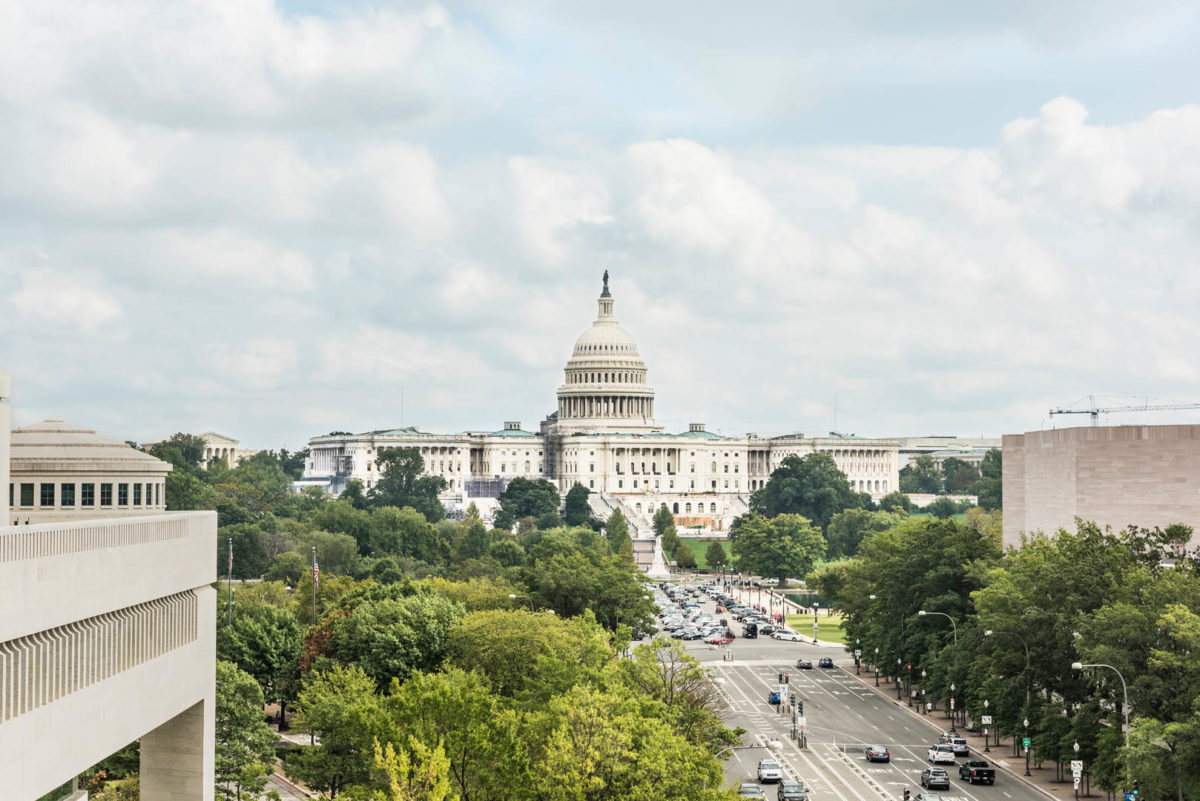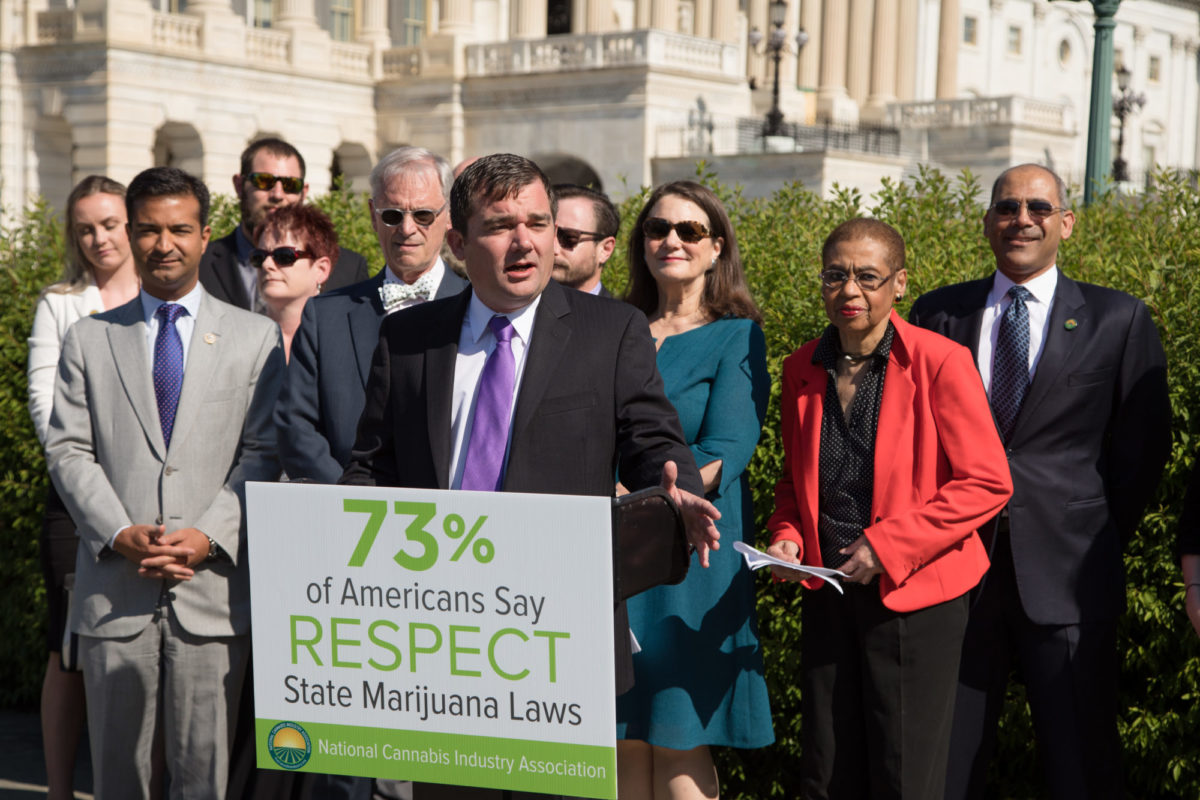The History of Appropriations

by Michelle Rutter, Government Relations Manager
Congress doesn’t spend much of their time on passing legislation, but one exception is how much time they spend on the nation’s annual spending bills. These bills, also commonly known as appropriations bills, are legislation in Congress that “appropriates,” or sets aside, federal funds to be divided between specific federal government departments, agencies, and programs.
Let’s take a look at the history of the appropriations process, and later, we’ll talk about how it all relates to cannabis.
Appropriations bills are one part of the larger federal budget and spending process. Congress’ ability to appropriate funds has its origin in the Constitution — Article I, section 9, clause 7 states that “No money shall be drawn from the Treasury, but in Consequence of Appropriations made by Law…” The President still has the power to veto appropriations bills, however, they cannot choose which provisions to keep and which to delete — the Executive must either approve or disapprove of the entire bill.
Regular appropriations bills are passed annually, with the funding they provide covering one fiscal year. The fiscal year runs from October 1 to September 30 of the following year. For example, Fiscal Year 2019 (FY2019) will run from October 1, 2018, until September 30, 2019. Appropriations bills are created, amended, and passed initially by the House and Senate Committees on Appropriations, both of which have twelve matching subcommittees, each tasked with working on one of the twelve annual regular appropriations bills. Each of those twelve subcommittees deals with a different subject.
As Congress has become increasingly partisan, another type of appropriations bill, the continuing resolution (CR), has gotten much more popular. If a new fiscal year begins and Congress has not passed some — or all — of the regular appropriations bills, Congress can extend their funding authority from the previous year, with possible minor modifications, using a continuing resolution. Think of a CR as a “copy and paste” of the appropriations bill, with possibly a few other provisions added. If all twelve regular appropriations bills have been passed, a continuing resolution is unnecessary.
There are various points throughout the appropriations process where members of Congress may introduce amendments to the bill being considered. They may be introduced in committee by a member of either chamber’s Appropriations Committee, or they may be submitted to the powerful Rules Committee. In recent years, the Rules Committee has been overcome by partisanship and has essentially blocked the minority’s amendments. This has made it difficult for any topic that can even be considered as somewhat “controversial” to be addressed.
In next week’s installment, we’ll talk about how the appropriations process relates to cannabis policy and how NCIA has moved the dial in recent years. Stay tuned!
The Future of Medical Cannabis Reform – Now What?
by Michelle Rutter, NCIA Government Relations Manager
Late in the evening of September 6th, the House Rules Committee held a hearing to discuss amendments to the upcoming appropriations bill that will fund the federal government for the upcoming fiscal year. The Rules Committee is used by House leadership to maintain control over the House floor, and is heavily stacked in favor of the majority party (by a 2:1 ratio).
Unfortunately, the committee decided not to allow the Rohrabacher-Blumenauer amendment (formerly the Rohrabacher-Farr amendment) to move forward for a vote on the Floor. Despite the fact that 46 states have legalized some form of cannabis, 90% of the public supports medical marijuana, and over 70% think the federal government should not interfere with state marijuana reforms, the Rules Committee singlehandedly decided to strip out the language protecting states’ medical marijuana laws that have been in law since 2014.
Although this came as no surprise, it is still disappointing. So, what’s next going forward? There are a couple of possible scenarios.
Scenario 1: In July, the Senate Appropriations Committee passed an amendment offered by Vice Chairman Patrick Leahy (D-VT) by a voice vote. The Leahy amendment is identical to the Rohrabacher-Blumenauer amendment and would protect medical cannabis businesses and patients for another year. If this legislation passes the Senate, the opportunity still exists for Congress to reconcile the differences and agree to maintain the current protections in medical cannabis states.
Scenario 2: There are rumors circulating that Congress will pass a funding bill for Hurricane Harvey relief and that this bill would include a debt ceiling increase and continue funding the federal government through mid-December. If this happens, the Rohrabacher-Farr amendment will continue to protect medical cannabis patients and businesses until a new appropriations bill is passed.
Scenario 3: Neither the House or the Senate agree to maintaining this provision, and Congressional protections for states’ medical cannabis laws disappear in the short term. Although this is the worst scenario of the three listed here, the opportunity still exists for Congress to re-insert this provision during next year’s budget negotiations.
NCIA will continue to advocate and communicate with Members of Congress on the behalf of the cannabis industry. While the House Rules Committee has made a disappointing decision, there is still hope that the Rohrabacher-Blumenauer/Leahy amendments will be included in federal law for yet another year. As we continue to represent our member-businesses, we will be vigilant in our efforts to bring about the best possible positive outcome in the current political climate.
Top 5 Amendments To Watch For In Congressional Committee Next Week

by Michelle Rutter, NCIA Government Relations Manager
Every year, Congress must pass appropriations legislation to fund the government for the upcoming fiscal year. This annual budget bill, which is currently set to expire on September 30th, has been one of the only avenues by which pro-cannabis reform language can be inserted into federal law– even if only for a year at a time.
But, like most things in Washington, D.C., the appropriations process is lengthy, complicated, and chock full of procedure.
 Early next week, the House Rules Committee will hold a hearing to discuss amendments to the upcoming appropriations bill that will fund the government for FY2018. The Rules Committee is used by leadership to maintain control over the House floor, and is heavily stacked in favor of the majority party (by a 2:1 ratio). Despite that, over a dozen cannabis related amendments have been filed and submitted by various members of Congress, but it is up to the Rules Committee to determine which provisions will be ruled “in order.” Let’s take a look at a few of the amendments that, if passed, could significantly affect the cannabis industry:
Early next week, the House Rules Committee will hold a hearing to discuss amendments to the upcoming appropriations bill that will fund the government for FY2018. The Rules Committee is used by leadership to maintain control over the House floor, and is heavily stacked in favor of the majority party (by a 2:1 ratio). Despite that, over a dozen cannabis related amendments have been filed and submitted by various members of Congress, but it is up to the Rules Committee to determine which provisions will be ruled “in order.” Let’s take a look at a few of the amendments that, if passed, could significantly affect the cannabis industry:
Rohrabacher-Blumenauer Amendment: This provision, formerly known as the Rohrabacher-Farr amendment, has been included in the federal budget since 2014. The amendment bars the Department of Justice from interfering with states’ medical cannabis laws and businesses. Those protections will expire on September 30th if this amendment is not renewed. The amendment has 12 cosponsors: seven Republicans and five Democrats.
McClintock-Polis Amendment: First introduced in 2015, this amendment would ban the Department of Justice from interfering with states’ adult-use cannabis laws and businesses. When voted on in 2015 on the House floor, the amendment narrowly failed.
Heck Amendment (1): This amendment would protect financial institutions that choose to service the cannabis industry from interference from the federal government. The provision protects banks in adult-use states, medical cannabis states, and CBD-only states.
Heck Amendment (2): The second cannabis related amendment introduced by Congressman Heck would prohibit any changes to the guidance issued by the Financial Crimes Enforcement Network titled “BSA Expectations Regarding Marijuana-Related Businesses.”
Heck Amendment (3): Similar to the second Heck amendment, this provision would prohibit the Department of Justice from revoking the guidance issued by the Financial Crimes Enforcement Network titled “BSA Expectations Regarding Marijuana-Related Businesses.”
It is important to note that in recent years, House Republicans have essentially shut down the appropriations process by not allowing any controversial amendments (including cannabis) to be ruled “in order”. Just a few months ago, the Rules Committee blocked a measure that would have allowed Veterans Affairs physicians to talk to their patients about medical cannabis in states where it’s legal. Should this happen next week, NCIA will be working closely with our allies and Members of Congress to ensure that the Senate’s version of the budget bill, which does include the Rohrabacher-Blumenauer amendment, is passed into law.
Navigating Congress and all of its procedural quirks can be stressful and difficult, but that’s what NCIA is for. Stay tuned for updates on appropriations throughout September as we continue to watch this process unfold.



 Early next week, the House Rules Committee will hold a hearing to discuss amendments to the upcoming appropriations bill that will fund the government for FY2018. The Rules Committee is used by leadership to maintain control over the House floor, and is
Early next week, the House Rules Committee will hold a hearing to discuss amendments to the upcoming appropriations bill that will fund the government for FY2018. The Rules Committee is used by leadership to maintain control over the House floor, and is